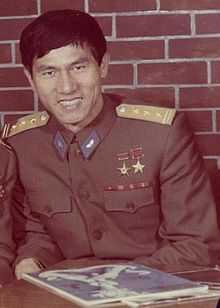Phạm Tuân
| Phạm Tuân | |
|---|---|
 | |
| Vietnam People's Air Force / Intercosmos Research Cosmonaut | |
| Nationality | Vietnamese |
| Status | Retired |
| Born |
February 14, 1947 Thái Bình, Vietnam |
| Previous occupation | Pilot |
| Rank |
|
| Time in space | 7d 20h 42m |
| Selection | 1979 Intercosmos Group |
| Missions | Soyuz 37 / 36 |
| Mission insignia |
|
| Awards |
|
Phạm Tuân (born February 14, 1947) is a retired Vietnam Air Force aviator. He became the first Vietnamese citizen and the first Asian (outside of Russia) in space when he flew aboard the Soyuz 37 mission as an Intercosmos Research Cosmonaut.[1][2] He was awarded the title Hero of the Soviet Union.
Early life and military career
Pham Tuan was born in Quốc Tuấn, Thai Binh province in northern Vietnam. He joined the VPAF, or Vietnam People's Air Force (North Vietnamese Air Force) in 1965, was later commissioned as a combat officer. He flew interceptor missions in a MiG-21 jet fighter against United States aircraft during the Vietnam War.
On the night of December 26, 1972, during Operation Linebacker II (also referred to as the Christmas Bombings), then Major Pham engaged a USAF Strategic Air Command (SAC) B-52 Stratofortress heavy bomber with air to air missiles. He reported his missiles struck the B-52, and claimed his attack caused it to go down in flames. This claim, which would be the only B-52 downed in aerial combat, is disputed by the US government. The U.S. states that the B-52 was downed by a surface to air missile, as were all other B-52s shot down during the campaign. No additional evidence has been presented to verify the claims.[3] Other sources said that US government has not accepted the loss and tried to refuse the facts that B-52 were shot down during Linebacker II in Vietnam by a MiG-21[citation needed]. The number of US military aircraft shot down in the North of Vietnam from August 5, 1964 to January 7, 1973 is 4,181, in which the number of B-52s and F11s is 68 and 13 respectively.[citation needed]
Tuan received numerous high distinctions for his service, including the Ho Chi Minh Order. He also was awarded the Order of Lenin and the rare honor of being one of the few foreigners to receive the title "Hero of the Soviet Union".
Intercosmos program
Tuan reached the rank of lieutenant colonel in the VPAF before eventually training to be a research cosmonaut in the joint USSR-Vietnamese Space program. On April 1, 1979, he was selected as a member of the sixth international crew for the Intercosmos program. His backup was Bùi Thanh Liêm. Tuan, along with Soviet cosmonaut Viktor Gorbatko, was launched from Baikonur Cosmodrome on July 23, 1980, on board Soyuz 37 en route to the Salyut 6 station.
During his time in orbit, Tuan performed experiments on the melting of mineral samples in microgravity. He also carried out plant experiments on azolla and photographed Vietnam from orbit for mapping purposes. Tuan was in space for 7 days, 20 hours, and 42 minutes. He completed 142 orbits, and was returned to earth on July 31, 1980.
Personal life
Tuan is married and has two children. He is now a retired lieutenant general, director of the General Department of Defense Industry of the Ministry of Defense, and is a non-elected member of the Vietnam National Assembly.
References
- Toperczer, Istvan. MiG-21 Units of the Vietnam War. 2001, Osprey Publishing Limited. ISBN 978-1-84176-263-0.
- ↑ Encyclopedia Astronautica (2007). "Salyut 6 EP-7". Encyclopedia Astronautica. Retrieved October 4, 2007.
- ↑ Man-In-Space Firsts
- ↑ Toperczer, p. 66